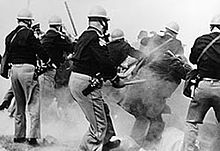This article is missing information about history, especially during the Civil Rights era.(December 2021) |
This article may rely excessively on sources too closely associated with the subject , potentially preventing the article from being verifiable and neutral.(December 2021) |
| Montgomery Police Department | |
|---|---|
| Abbreviation | MPD |
| Motto | Honor - Duty - Loyalty |
| Agency overview | |
| Formed | 1820 |
| Jurisdictional structure | |
| Operations jurisdiction | Montgomery, Alabama, USA |
 | |
| Map of Montgomery Police Department's jurisdiction | |
| Size | 156.6 square miles (406 km2) |
| Population | 205,764 |
| General nature | |
| Operational structure | |
| Headquarters | Montgomery, Alabama |
| Officers | 524 |
| Civilians | 200 |
| Divisions | 8
|
| Website | |
| Montgomery Police Department | |
The Montgomery Police Department (MPD) was established in 1820. It is budgeted for 490 sworn officers, however currently possess around 220 and around another 80 support staff. It is headed by Interim Chief of Police James N. Graboys. [1]

